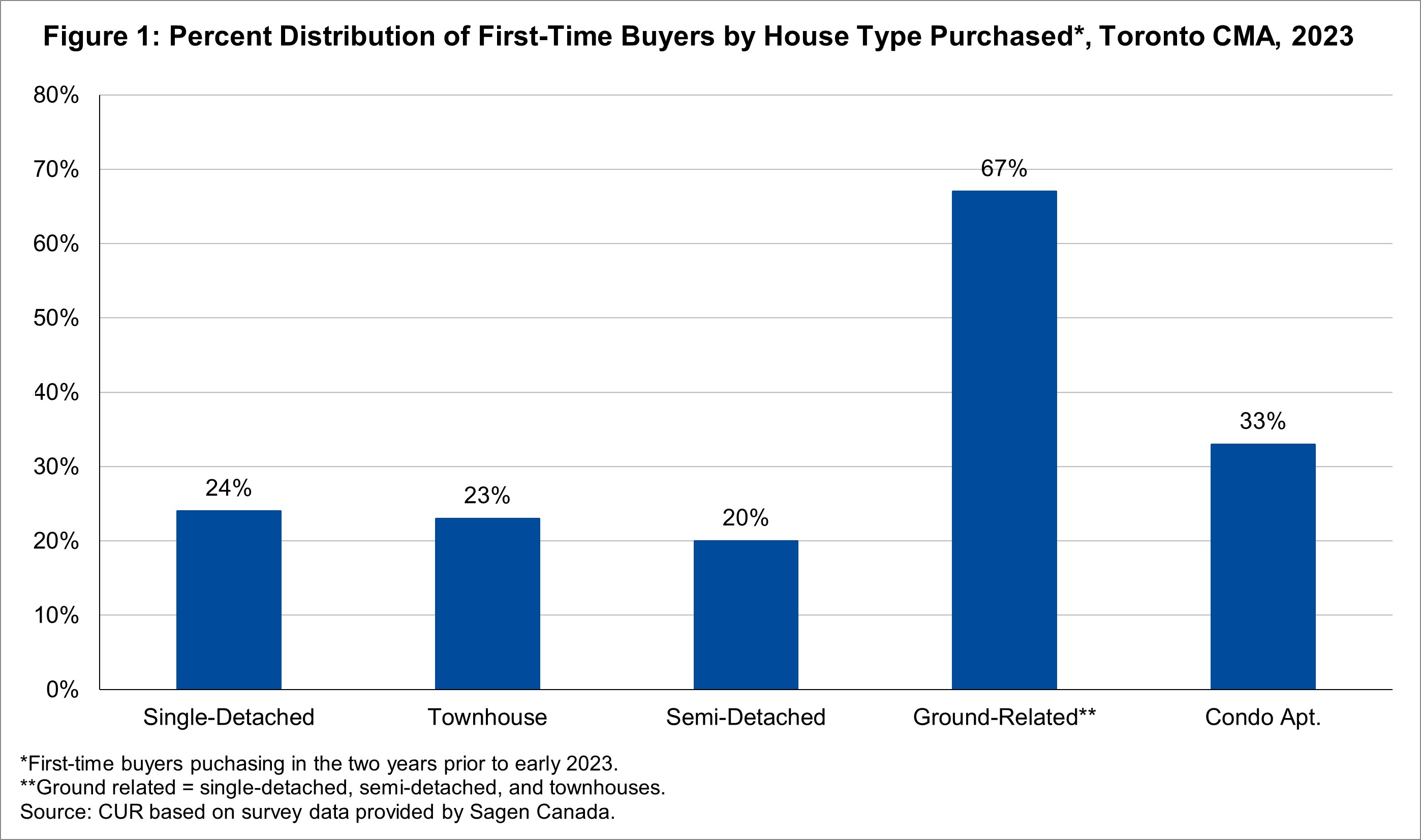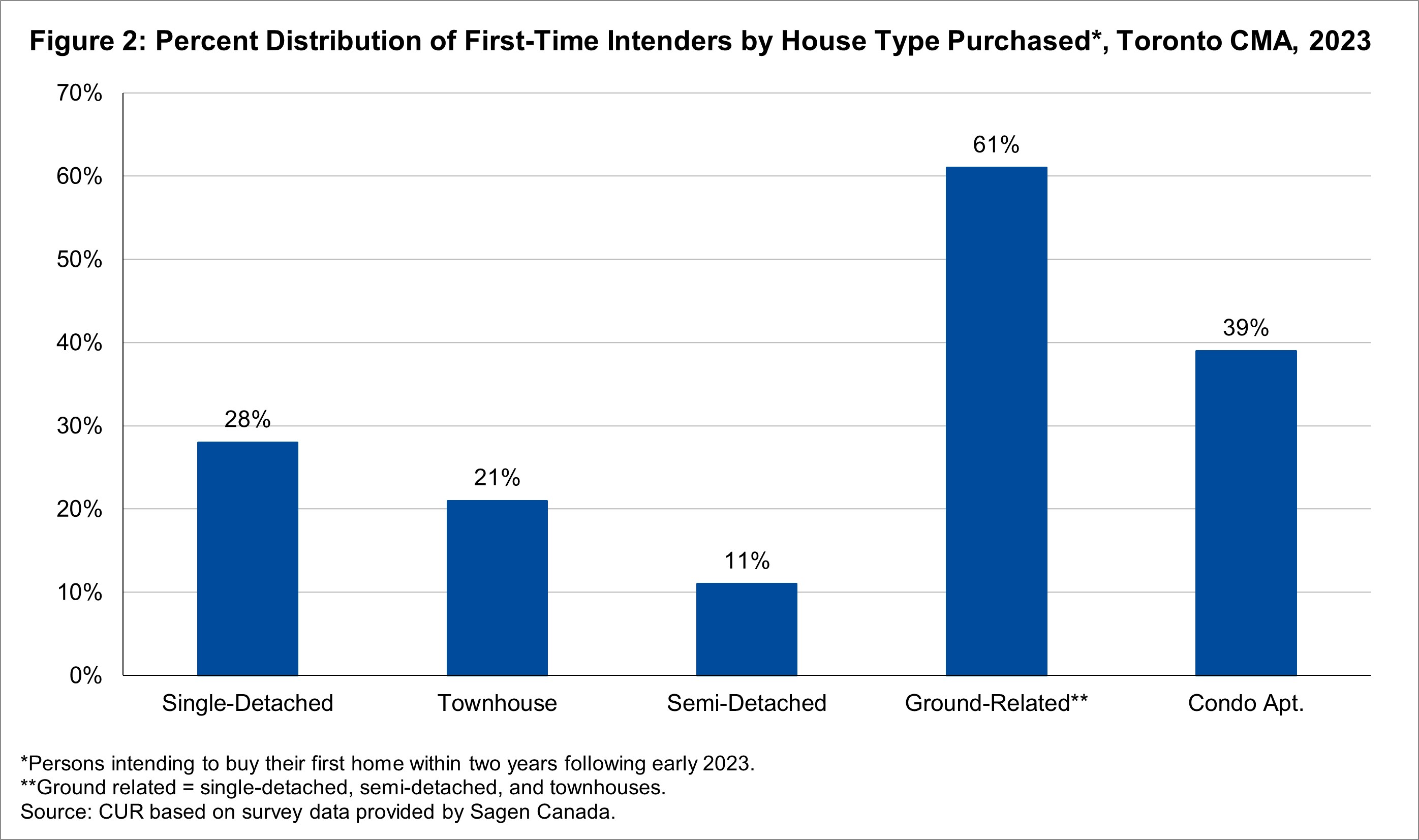Why do the “Experts” Treat Housing Types as Irrelevant?
By: Frank Clayton, Senior Research Fellow
May 7, 2024
(PDF file) Print-friendly version available
Executive Summary
A sizeable cadre of planning and housing "experts" in the Toronto region regard the housing preferences of residents as irrelevant to the pursuit of addressing housing supply objectives. A recent example of "housing experts and practitioners" ignoring housing types is a March 2024 report from the Task Force for Housing & Climate, Blueprint for More and Better Housing, which does not consider market dynamics. Understanding and utilizing the demand and supply forces of the housing marketplace is a critical element of the policy if we are to reach a compromise in addressing affordability and environmental concerns.
This blog highlights a 2023 survey released by Sagen Canada, which included data on the types of housing first-time buyers buy in the Toronto region. It demonstrates the strength of the demand for ground-related housing. Ignoring these revealed preferences will result in higher housing prices, a greater dispersion of population, longer commutes, and more greenhouse gas emissions.
Introduction
In non-market economies, much of the housing is provided by governments, and residents often have little or no choice regarding housing type and location. In market economies, planning regulatory regimes, to varying degrees, constrain the location and type of housing built. It is vital that planning regimes take into consideration market forces to ensure that shortages do not occur either overall or for some types/locations of units. Otherwise, prices will be adversely impacted. In this regard, the Province's Affordable Housing Task Force advocated ". . . growth in the full spectrum of housing supply."[1]
Surprisingly, some "housing experts" want to extend the philosophy of overtly constraining and prescribing the types and locations of housing built. They envision all metropolitan area housing being built through intensification and redevelopment within the existing built-up urban boundaries. The result is that most new housing should be apartments, ranging from duplexes to apartment towers, as defined by the Canada Mortgage and Housing Corporation (CMHC) in its starts and completion survey. Building housing on what is now greenfield lands (e.g., farmland) is considered evil sprawl by many. The kinds of housing and locations that households inherently desire are treated as irrelevant to the pursuit of environmental and sustainability objectives.
A March 2024 report from the Task Force for Housing & Climate, Blueprint for More and Better Housing, asserts that it is possible to build 5.8 million affordable, low-carbon, and resilient homes across Canada by 2030.[2] From my reading of the report, virtually all new housing must be built in existing built-up areas in various apartment types.[3]
This disconnect between market reality and the "experts," let alone the "practitioners," amazes me. Survey after survey documents the importance of housing types in households' home-buying decisions. Ground-related homes (singles, semis, and townhouses) are not only the most desired housing type but also the housing that people buy. Several CUR releases have discussed the discrepancy between experts and buyers and its implications.[4]
Yet, as noted below, surveys demonstrate the inherent draw of ground-related housing forms for homebuyers, even first-time buyers in the Toronto census metropolitan area (CMA).
First-time buyers and intender buyers continue to demand ground-related homes in the Toronto Census Metropolitan Area (CMA)
This section highlights results from a survey of first-time buyers undertaken by Sagen Canada in collaboration with Environics Research and the Canadian Association of Credit Counselling in early 2023.[5]
About the survey
A total of 436 persons aged 25-45 living in Toronto who had either purchased their first home within the prior two years (“first-time buyers”) or planned to buy their first home in the next two years (“first-time intenders”) were surveyed. This was part of a national survey interviewing 2,223 first-time and intender buyers. Sagan Canada provided CUR with unpublished results for the Toronto CMA.
The housing types utilized in the survey do not coincide precisely with the more common definitions used by Statistics Canada and CMHC. In consultation with Sagen Canada, we have adapted their terminology as follows (with Sagen’s labels in brackets):
- Single-detached house (fully detached house)
- Semi-detached house (duplex/semi-detached home)
- Townhouse (townhouse/rowhouse)
- Condo apartment (condominium)
Two-thirds of Toronto CMA first-time buyers bought a ground-related home
Figure 1 shows the types of homes purchased by Toronto CMA first-time buyers in the two years before early 2023.

Only a third of first-time buyers purchased a condo apartment. The remaining two-thirds were spread across the ground-related housing types: single-detached houses (24%), semi-detached houses (20%) and townhouses (23%).
Comparing the 2023 survey results with the early 2021 Sagen survey, there was a significant shift in buying by first-time buyers from ground-related homes (from 77% to 67%) to apartments (23% to 33%).[6] The marked decline in housing affordability and perhaps less pandemic-induced demand for more space influenced the changing mix in homes purchased. Still, ground-related homes dominated.
More intender buyers plan on purchasing an apartment, but ground-related homes are predominant
Figure 2 presents the survey results for persons intending to buy a home over the two years beyond early 2023 (called intenders).

Nearly 40% of intender first-time buyers planned on buying a condo apartment compared to what a third of recent first-time buyers purchased. Single-detached houses were the most common form of ground-related housing desired (28%), followed by townhouses (21%) and semi-detached houses (11%).
It is time for the "experts" to get real – any solution to the affordability crunch in the Toronto CMA must include ground-related housing built on greenfield land
I end with words of wisdom from an insightful urban observer, Alain Bertaud, on the folly of freezing all greenfield development, as quoted in a July 2002 CUR blog entry dealing with the commonly mistaken impression that all greenfield development is sprawl: "Setting arbitrary spatial barriers to urban expansion, such as green-belts and UGBs [urban growth boundaries], however, results in higher land and housing prices, longer commute times, and other negative outcomes as demonstrated in Hanoi's master plan".[7]
Endnotes
[1] “Report of the Ontario Housing Affordability Task Force.” February 2022.
[2] Task Force for Housing & Climate. Blueprint for More and Better Housing: How Federal. Provincial and Municipal Governments Can Ensure We Build 5.8 Million Homes That Are Affordable, Low-Carbon and Resilient.
[3] I do not comment here on the inherent inconsistency between housing affordability and environmental sustainability. A topic for another day.
[4] See Frank Clayton. What Kinds of Housing are Homebuyers or Intending Homebuyers in the GTHA Choosing? CUR. June 28, 2022. The paper concluded: “This disparity between housing demand and supply [by unit type] sets the stage for housing prices to move even higher in the coming years, with adverse consequences for younger and immigrant households and a more unequal distribution of wealth among households in the Greater Toronto and Hamilton Area ("GTHA"). As in recent years, these higher housing prices will encourage many households to move further away from employment nodes, searching for affordable types of ground-related homes.”
[5] Sagen Canada. 2023 First-Time Homebuyers Trends & Their Financial Fitness.
[6] Clayton. Op.cit. Figure 4.
[7] Alain Bertaud. Order without Design: How Markets Shape Cities. Cambridge: MIT Press. 140
References
Alain Bertaud. (2018). Order Without Design: How Markets Shape Cities. Cambridge: MIT Press, 140.
Frank Clayton. (2022). What Kinds of Housing are Homebuyers or Intending Homebuyers in the GTHA Choosing? CUR. Available [Online]: https://www.torontomu.ca/content/dam/centre-urban-research-land-development/CUR_Preference_Homebuyers_Intending_Hombuyers_GTHA_June_2022.pdf
Frank Clayton and David Amborski. (2022). Is All Greenfield Development in the Greater Toronto and Hamilton Area Sprawl? A Resounding No. Available [Online]: https://www.torontomu.ca/centre-urban-research-land-development/blog/blogentry68/
Report of the Ontario Housing Affordability Task Force. (2022). Available [Online]: https://files.ontario.ca/mmah-housing-affordability-task-force-report-en-2022-02-07-v2.pdf
Task Force for Housing & Climate. (2024). Blueprint for More and Better Housing: How Federal. Provincial and Municipal Governments Can Ensure We Build 5.8 Million Homes That Are Affordable, Low-Carbon and Resilient. Available [Online]: https://housingandclimate.ca/wp-content/uploads/2024/03/Blueprint-for-More-and-Better-Housing-Mar-2024-EN.pdf
Sagen Canada. (2023). 2023 First-Time Homebuyers Trends & Their Financial Fitness.